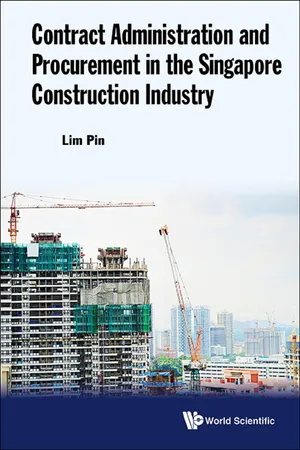![]()
CHAPTER 1
Introduction
For an introductory chapter, the Author wishes to provide a brief overview of the book. More detailed analysis will be discussed in subsequent chapters. This chapter will discuss the following:
1.1Parties in a Construction Project
1.2Roles of and Relationship Between Parties
1.3Time-Line in a Construction Project
1.4Pre-contract Administration
1.5Post-contract Administration
1.1 Parties in a Construction Project
The main parties involved in a construction project are as follows:
1.1.1Owner or Developer
1.1.2Project Manager
1.1.3Architect, Civil & Structural Engineer (“C&S Engineer”), Quantity Surveyor (“QS”), Mechanical & Electrical Engineers (“M&E Engineers”) and other Consultants
1.1.4Main Contractor
1.1.5Sub-Contractors
1.1.6Suppliers
1.1.1 Owner or Developer
An owner of land (“Owner”) has the power to decide whether to build on his land. It may be for the purpose of building a residential house or developing a block of apartments for sale or for other commercial uses. The Owner may be a private sector owner or public sector owner of properties as follows:
1.1.1.2 Private sector
Person(s) or companies may own properties. They may decide to build a house on the land. A developer of condominiums is also a private owner. They may build condominiums for sale with a commercial objective. Examples of developers in Singapore are Far East Organization, CapitaLand Limited, and City Development Limited.
1.1.1.3 Public sector
The Government is also an owner of properties. The State may own properties directly or through many of the Government-supervised statutory boards. Examples of property-owning statutory boards are the Housing Development Board (“HDB”), Land Transport Authority (“LTA”), and Sentosa Development Corporation.
1.1.2 Project Manager
Traditionally, the Architect, being the leader of the consultancy team, doubles up as the Project Manager in the management of the project. Due to present day's large and complicated projects, there is usually a Project Manager. He is accountable to the Owner in managing the whole project to ensure that it is completed on time and within budget. The Project Manager may be qualified as an Architect, an Engineer, a Quantity Surveyor or other professions as long as the person is competent and experienced in the management of construction projects. The Architect and other consultants take direction from the Project Manager.
There may be Project Managers in the Private sector or Public sector as follows:
1.1.2.1 Private sector
There are Project Managers employed in-house in developer companies e.g. Far East Organization, CapitaLand Limited. They act in the interest of their developer employers to ensure that the external consultants who were out-sourced and contractors who were engaged carry out their duties properly.
Project Managers may also provide their services to developers in their capacity as out-sourced firms, e.g. CPG Corporation. These firms provide project management services to developers in consideration for a fee.
1.1.2.2 Public sector
There are Project Managers employed in-house in statutory boards, e.g. HDB, LTA, to manage and oversee projects. The statutory boards may also out-source the project management services to other project management firms.
1.1.3 Architect, Engineers, Quantity Surveyor and Other Consultants
Professionals, such as Architects, Engineers and Quantity Surveyors, known as Consultants provide services in design, supervision of works, cost management and other professional services. Architects, Engineers and Quantity Surveyors may be employed in the private sector in developer companies or practice respectively in architectural, engineering, quantity surveying or multi-disciplinary firms. A multi-disciplinary firm is a firm which provides different professional services such as architectural, engineering, quantity surveying and other consultancy services within the same firm.
Such professionals may also be employed in the public sector, e.g. HDB.
1.1.3.1 Architect
Usually, the Owner appoints an Architect first to provide the concept design for the Owner's approval. Traditionally, the Architect is the leader of the consultancy team consisting of the Architect (as team leader), the Civil and Structural Engineer, the Mechanical and Electrical Engineers, and the Quantity Surveyor.
1.1.3.2 Civil and structural engineer
Upon approval of the concept design, the Architect would forward the design to the Civil and Structural Engineer (“C&S Engineer”). The C&S Engineer has to make sure that the design is structurally sound by designing a system of piles, reinforced concrete beams and columns to carry the load of the building itself and fixtures, known as the dead load, and the movable load such as furniture and persons in the building, known as the live load.
1.1.3.3 Quantity surveyor
Upon approval of the concept drawings by the Owner (mentioned in para. 1.1.3.1), the Quantity Surveyor (“QS”) would be requested to provide an estimate for the cost of the construction project. Naturally, the estimate should meet with the Owner's approval before proceeding with the detailed design.
The estimate approved by the Owner will usually be the budget set by the Owner for the construction and completion of the project. It would be the responsibility of the consultancy team to ensure that the cost of the project is kept within the budget set by the Owner.
1.1.3.4 Mechanical and elec...
